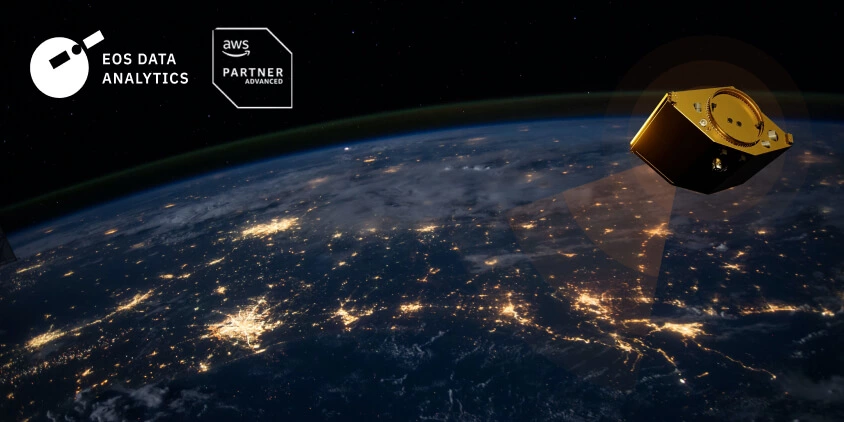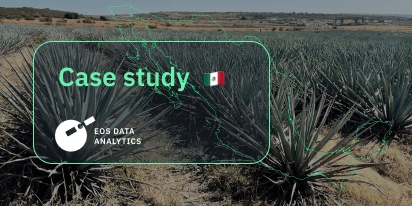
A Functional Synergy Of EOSDA And AWS In Earth Observation
EOSDA, a global provider of AI-powered satellite data analytics, has long been collaborating with Amazon Web Services (AWS), a leading cloud service provider, to meet its needs for robust computational power.
From data storage to machine learning, AWS’s extensive cloud services allow EOSDA to provide its clients with actionable insights derived from satellite data and implement its long-term vision of making space tech a global driver of sustainability on Earth.
AWS And EOSDA: Collaborating To Boost Space Innovation
Initially, EOS Data Analytics implemented several key AWS services to kickstart their operations. Among these were scalable storage solutions, which were crucial for handling the large volumes of satellite data that EOSDA processes. Additionally, the efficient use of AWS Lambda enabled EOSDA to analyze this data quickly, thereby improving the speed and accuracy of their insights.
These services allowed the EOS Data Analytics team to streamline their operations and focus on our core competencies, like satellite data analysis for sustainability and customer engagement, rather than getting bogged down with the technical intricacies of infrastructure management.
The most appealing aspect of AWS for EOS Data Analytics is AWS’s pay-as-you-go model. This financial flexibility allows EOSDA to scale its operations without the burden of upfront costs and to ensure consistent customer experiences despite fluctuating data volumes and computational needs.
AWS Services In EOSDA Products
Today, the cloud infrastructure provided by AWS offers scalability and cost-efficiency and optimal performance for EOS Data Analytics solutions. Here’s how it looks in practice.
EOSDA relies on AWS Elastic Compute Cloud (EC2) instances for its core computing needs. Coupled with AWS Auto Scaling, EC2 allows EOSDA to flexibly scale its services based on load. This ensures fault tolerance while optimizing costs. The Auto Scaling feature is particularly useful for handling unpredictable spikes in demand, thereby maintaining a smooth user experience.
AWS Simple Storage Service (S3) serves as EOSDA’s primary data storage solution. Its flexible access policies enable EOSDA to store both public and private data securely. For instance, high-resolution satellite images ordered by EOSDA LandViewer users can be kept private, while other data intended for public consumption can be easily shared.
For regular, recurring tasks such as processing satellite imagery and ensuring data availability on AWS S3, EOS Data Analytics uses AWS Lambda. This serverless computing service allows the company to execute code in response to specific events, eliminating the need to monitor server states or loads. AWS Lambda ensures that EOS Data Analytics only pays for the compute time consumed, making it a cost-effective solution.
To ensure fault tolerance and speedy delivery of solutions to a global customer base, EOS Data Analytics relies on the AWS CloudFront and Amazon Elastic Load Balancing (ELB). These services distribute incoming traffic across multiple targets, such as EC2 instances, in multiple availability zones, thereby increasing the fault tolerance of the applications.
As a result, all of EOSDA’s solutions are implemented using a combination of AWS services. For example, AWS Simple Notification Service (SNS) and Lambda are used in tandem to update information about data availability on S3 buckets. Additionally, all EOSDA platform application interfaces (APIs) are deployed on Amazon EC2, ensuring seamless integration and efficient operation.
Balancing Power And Cost With AWS
One of the most compelling aspects of EOSDA’s collaboration with AWS is the ability to strike a balance between computational power and resource costs. AWS’s flexible, pay-as-you-go pricing model has been instrumental in this regard, allowing EOSDA to scale resources up or down based on real-time needs without incurring unnecessary expenses.
In addition, EOSDA employs several strategies to optimize costs while maintaining high performance:
- AWS Auto Scaling is used to automatically adjust the number of EC2 instances available based on the application’s needs.
- This ensures EOSDA is neither overpaying for idle resources nor compromising on performance during peak loads.
- AWS Lambda contributes to cost optimization by executing code only when needed and scaling automatically, so EOSDA pays only for the compute time consumed. This eliminates the need for constant server monitoring, further reducing operational costs.
Regular communication with AWS account managers and technical specialists provides insights into how to use AWS services more efficiently. These interactions help EOS Data Analytics to stay updated on new features and best practices for cost optimization.
Over the last couple of years, I’ve seen EOSDA develop robust cost optimization best practices while working with AWS. Their journey is a testament to the remarkable cost-saving potential of adopting cloud-based solutions.
By leveraging AWS’s flexible pricing and powerful tools, EOSDA has successfully managed to optimize its resource utilization. The cost-effective and reliable infrastructure allows EOSDA to fully focus on providing top-quality Earth observation data and analytics to its clients.
EOSDA LandViewer
Search for AOI-specific satellite imagery, apply custom band combinations and download for free.
EOS SAT-1 Agri-Focused Satellite And AWS
The integration of AWS services also helps EOSDA collect, store, and process data from the EOS SAT-1 satellite.
AWS’s robust and scalable cloud services are not just supporting EOSDA’s Earth observation services but are also playing a pivotal role in the management and operation of our satellite infrastructure.
EOS SAT-1 is a small optical agri-focused satellite launched in January 2023 that is able to monitor up to one million square kilometers daily using 11 agri-related bands. Making sure the images it provides are secure and quickly accessible has been of critical importance for EOS Data Analytics.
Today, for EOS SAT-1, AWS services like EC2 and Lambda are already in use for data processing and task automation. AWS S3 is being utilized for secure and scalable data storage, ensuring that the vast amounts of data generated by the satellite are readily available for analysis and distribution. AWS ELB ensures that the data and services are reliably and quickly accessible, providing fault tolerance and speed of delivery to clients worldwide.
EOSDA plans to further leverage AWS’s capabilities to manage increased data loads and more complex computational tasks. The company is particularly interested in AWS’s machine learning models for predictive analytics, which could be integrated into the satellite infrastructure for more efficient resource allocation and data processing.
Bottom Line: How AWS Fuels Innovation And Efficiency
The collaboration with AWS helps EOSDA implement its vision of making space tech a key driver of global sustainability in the most cost-effective and efficient manner. From the initial stages of choosing a cloud provider to the ongoing implementation and scaling of services, AWS has proven to be an invaluable asset to EOSDA.
Plans are already underway to migrate to AWS RDS (Relational Database Service) to further streamline database management. Moreover, EOSDA anticipates that advancements in AI technologies, potentially integrated through AWS, will offer even greater cost efficiencies.
For businesses considering a similar path, the EOSDA-AWS collaboration serves as a compelling case study. AWS makes the journey comfortable, guiding you through any knowledge gaps and even initiating meetings to help you make the most of their services. Their customer-centric approach ensures that you’re not just using their products but optimizing them for your specific needs.
So, if you’re looking for a cloud service that offers both power and cost-effectiveness while being committed to the idea of sustainable development, look no further. Collaborating with AWS is not just a choice; it’s a strategy for success.
About the author:
Maksym Sushchuk is at the forefront of realizing EOSDA's vision to make space tech a global driver of sustainability on Earth. He has over 15 years of experience in journalism and content creation for prominent Ukrainian startups, charitable funds and ESG businesses. As Head and Co-founder of PR Army Maxim brings attention to the human and social tolls of the aggression against Ukraine.
Recent articles

Digital Tools Improve Soil Health And Yields In Mexico
EOSDA and ITTA supported a Guanajuato farm with contour-line planning, monitoring tools, and practical guidance to reduce soil erosion and improve yields in the long run.

Analyze 2025 & Plan Your Best Year Yet: LandViewer Christmas Offer
It’s the most wonderful time of the year! The Christmas holidays are here, and so is your chance to analyze 2025 and plan a prosperous 2026 with more affordable Pro plans in LandViewer.

EOSDA Models Climate Change Impact On Sugarcane Yields
EOSDA modeled future temperature, rainfall, and other climate impacts on Veracruz sugarcane. The results help growers plan long-term adaptation strategies, including timing, varieties, and irrigation.